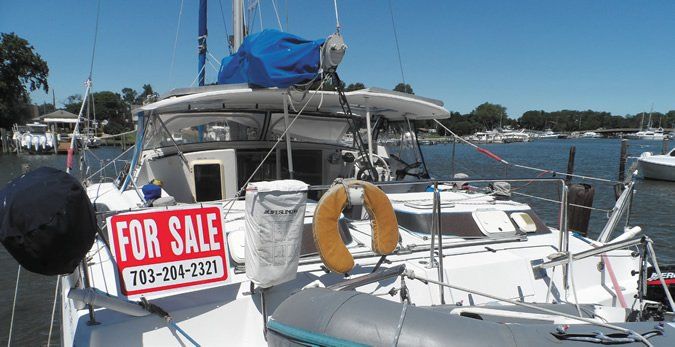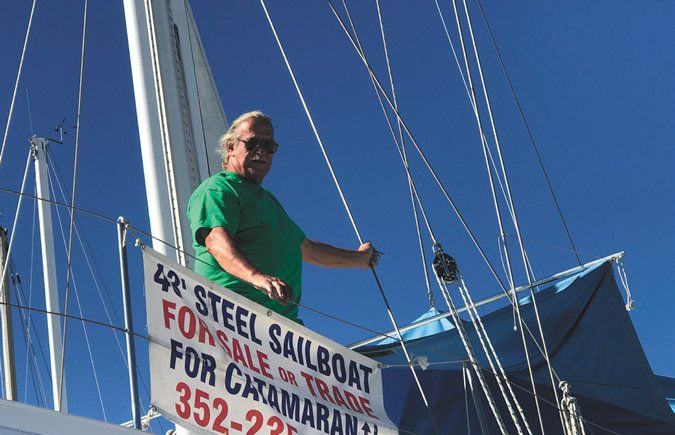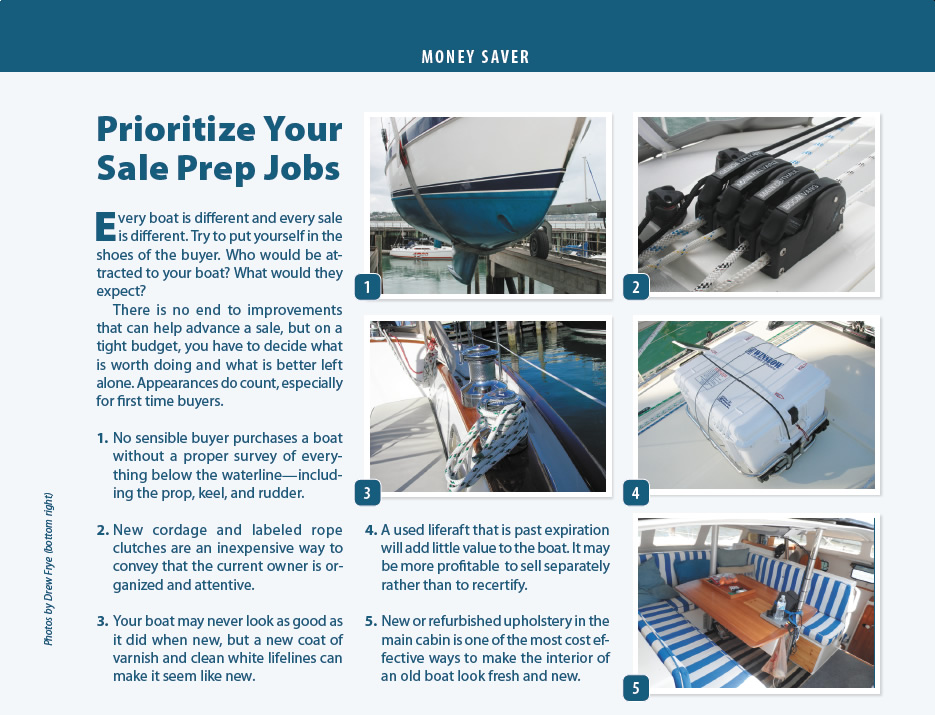I’m not anti-broker. I’ve happily used agents buying and selling boats and houses. They serve a valuable function, bringing buyers and sellers together, managing the viewings for out-of-town and busy owners, and generally helping the transaction go smoothly. They can serve as go-between during negotiations, inspections, and formalities. But they also represent a large expense in a transaction, generally 10 percent by default, though this may be negotiated lower (potentially with a reduction in service).

For the broker to bring value he must understand the value unique to your boat; boats that have been particularly well maintained or upgraded should sell above market. High-value brands an models should command a premium, if marketed properly. Multihulls can present unique challenges; as a catamaran owner, Ive struggled with brokers that didnt understand them at all. Another problem is lower value boats; below $30,000, the commission, after broker expenses, is simply not enough to motivate real effort. The bottom line is that in some cases you may be better off going it alone.
My first broker experience involved a Stiletto 27 catamaran. In spite of the fact that I had just bought a far more expensive boat through him, he looked at the boat and decided it was too strange, had limited cabin space, and was too low-value (about $14,000 in 2017 dollars) for his time. He suggested I might do better on my own, and I did, selling it for 90 percent of my asking price within two weeks.
My second experience involved selling a PDQ 32 catamaran; two different brokers suggested a listing prices 20-35% below the final closing price. My feeling in each case is that the broker did not understand what he was selling and wanted a quick sale. It was also obvious they had no intention of working for me. In each case I did my homework, or my sale by owner experiences would not be so positive.
Perhaps the greatest downside is buyer reluctance. Some folks are simply not comfortable going outside the safe broker pathway. The cure is to prepare the boat properly, put more and smarter efforts into marketing than the broker would, and to-as much as possible-follow the same transaction process a broker would follow. Without access to the same online marketing tools, such as those on www.yachtworld.com and all of its affiliates, the sale will likely take more time than it would with a broker, but owners of high-demand models such as cruising multihulls or cult boats like the Stiletto with a small but loyal fan base can overcome this handicap with their own efforts. And when it comes time for the sale, you can bring in third-party (or use the buyers broker) to help with the title and fund transfers.
Prepping For Sale
In Selling your Sailboat (see Practical Sailor, June 2017) we discuss the importance of delivering a clean, seaworthy boat. A well prepared boat sends two important messages to the buyer; the owner is professional in everything he does, and that sailing is fun. If the condition reflects high quality, consistent maintenance and repairs, the buyer will believe the sales process will be professional. If it is slap-dash, they will expect the sales process to be the same. Consider obtaining a condition of value survey before listing as an aid in identifying problems that will be identified in the buyer survey, and as a tool in determining a fair asking price.
Keeping it clean. Cleaning a sailboat is hard work. Keeping it clean is, well, nearly impossible. Ive washed a boat, gone inside for a drink of water, and returned to find 3 bird bombs on the deck. Cover the upholstery with towels when not showing. Put a doormat on the dock and wipe your feet; better yet, change shoes. Keep the cabin and locker doors open to ventilate when you leave. (Leave cabin doors open during a showing, otherwise the boat seems smaller.) Allow time for a quick deck scrub every two weeks at a minimum. Keep the head well flushed with fresh water (seawater causes smells), and run a dehumidifier if you can; boat smells and mildew send a subliminal message that it is a project boat with hidden deterioration.
Marketing. The greatest advantage of using a broker is access to Yacht World, the multiple listing service for boats. There are other ways, of course. A quick Google search of boats for sale will turn up numerous classified sites; some work (a free site www.sailboatlisting.com has turned up many serious lookers for me, and I have found boats there), most don’t. You can also take steps that many agent wont, including:
Network. Regular posting on owners forums, sharing your experience, identifies you as an enthusiastic and involved owner. Many boats sell by word of mouth.
Blog. Not only is it a fun and flexible way to share your experiences with friends and fellow sailors, when the time comes to sell the boat, it is a source of traffic and a great place to host a detailed for-sale page that you can link to. (This can backfire, however, if your blog highlights groundings, gear failures, major repair work, etc.)
Owners forum. Nearly as good as word of mouth, these can generate fast sales, since the site visitors are often focused, with just one brand and model in mind. If you have participated in the forum you will be known there, further increasing your word-of-mouth advertising. Smart buyers will search your posts. Most owners forums have a classified section.
Showing the Boat
Get there early and give her a morning bath. At a minimum, always clean the windows and dodger vinyl windows. Turn on the air conditioning and refrigerator if applicable. Show the client around the boat, following their lead and answering questions. Point out less obvious features and explain why certain upgrades are fun or useful. Fun stories can help, but avoid stories involving misadventure or damage. When the questions slow down, make yourself scarce for 15 minutes so the buyers can discuss her virtues in private.
Owner’s Exclusions. Although you did not engage a broker, you might be approached by a broker representing a buyer. In this situation, it is best to ask the broker for an owner’s exclusion. This protects everyone. It states that if the broker brings you a buyer, the broker gets the commission, but that if you find the buyer on your own and handle showings, survey, sea trial, and closing, you don’t pay any commission. These will be worded differently and not every broker will offer this option. Bottom line: if a broker approaches you and says that he/she has a buyer, ask for an owners exclusion before signing the listing agreement. You can also ask for a modified arrangement, where the broker handles money through an escrow account and handles the closing and you pay a partial commission.

Survey
The survey process provides protection for both the buyer and the seller. The buyer benefits from a thorough inspection by a skilled professional, and he will need a survey to get financing and insurance on a larger boat. His risk of buying a lemon is no different than if he went through a broker. It also protects the buyer; unless a known defect is intentionally hidden, the buyer cannot dispute the condition of the boat after the sale; it has been formally agreed upon. The survey is at the buyers expense and the surveyor should be selected by the buyer.
Get there early. Open things up, air things out, and turn on any equipment that will be tested. If the buyers will be present, give her a morning bath and straighten up.
Clean the bilges and empty any lockers that contain equipment that requires inspection (through hulls, sump pumps, crash tanks, wiring, steering gear, tanks). The surveyor will be in a better mood and get a better impression if he doesn’t have to move your junk and get filthy. There is also a human tendency to down rate dirty equipment.
Additional equipment. Important items from the convey list should be present, but stacked in an out of the way location.
Be there. Don’t lean over his shoulder, but be instantly available, ready to answer any question about how something operates or how something was repaired.
Offer to repair. Sometimes small things will come up that can be repaired before the report is finalized. Alternatively, you can offer to take the repair cost off the price. The surveyor should be able to give an estimate. Take this as the price. Buyers often prefer this since they get to control the repair.
In the case of a smaller boat, say less than $15,000, an experienced sailor may wave the survey and perform his own inspection. However, whether by formal survey or personal inspection, require that the buyer sign a Vessel Acceptance Form, indicating that the inspection was acceptable, potentially with a few conditions and notes as to how they will be resolved (repair or price adjustment, though repair is often in the sellers best interest if it is minor).
Sea trials
These are part of the survey and are performed with the surveyor on board. On the other hand, if you like to sail and buyer interest seems sincere, there is no reason not to go for a ride. Let them drive once you reach open water and keep it lighthearted. It is fair to ask if they intend to make an offer, though it may be unwise to press for an exact figure. A waste of time? Maybe, but you said you liked sailing and it is an excellent opportunity to demonstrate that the vessels systems are dialed in.
Get there early. If you need to start the engines, allow enough time for the engine to cool. A savvy buyer will want a cold start, and might be suspicious if the engine has already been warmed up. Give her a morning bath and wash the windows. If there is air conditioning or a refrigerator, make sure they have reached temperature. Lines should be prepared for sailing. Remove all covers.
Ask the surveyor what he plans to do. Typically you will motor for long enough to warm up the engines, and then long enough at higher throttle to check for overheating, vibration, and speed. Then the sails will go up, so motor toward a good location (nice breeze, smooth water, searoom).
Make it a fun experience. Let the buyer drive, if he is comfortable with that, but recognize that there is a liability to have an inexperienced sailor at the helm. Make it fun.
Haulout
No boat purchase should happen without a haul out to inspect the hull bottom. The buyer always pays for this, and under normal circumstances the cost of getting the boat to the haulout facility is often born by the owner. This lets the buyer and the surveyor check the hull for gelcoat blisters and any potentially major issues. This is often the last step for a boat that is kept in the water.
Closing the Deal
For small boats, when the value is comparable to a car, a good handshake should be sufficient, combined with a bill of sale and a title. Funds should be paid as cash, you can turn to your local bank to provide notarized signatures and facilitate a wire transfer
With large boats, try to mirror the broker process as much as possible. A contract similar to the Yacht Purchase and Sale Agreement of the Yacht Brokers Association of America insures that everybody understands the process and their responsibilities.
The broker will typically place the deposit in escrow, though escrow service can be provided by any law office for a small fee. The deposit is refundable if the survey reveals anything significant, or honestly, if the buyer simply feels the boat handles poorly, a subjective judgment that is difficult to refute. The conditions required for a deposit refund, and the procedure for making the refund, must be clearly defined.
Title and documentation service companies, frequently assisted by a lawyer, are an inexpensive alternative to brokers for managing deposits and closing. For about $500 and charge of 2 to 3 percent of the escrow value, they will set up the escrow account and manage the paperwork until the funds clear. Many brokers will also manage closing and escrow for substantially reduced fees, often as low as 2 percent. In all cases, exercise diligence in choosing a closing company; surveyors any large yacht yards can be good sources of recommendations. Some brokers will provide this service for a fixed fee.
In general, the required paperwork includes:
Yacht Purchase and Sale Agreement.
Vessel Acceptance Form.
State title for the boat and tender.
Bill of sale, both state and US Coast Guard. It is common to change states during the sale process; a title company can help with this. Sale tax must be paid as applicable.
US Coast Guard Documentation Certificate, if applicable. The Title and documentation service can provide documentation transfer services, or the new owner can do that, but it is best if the chain of documentation is continuous.
If the boat is documented (i.e. registered with the federal government per U.S. code), the transfer of ownership process can vary by state. With a documented vessel, any liens will be filed with the US Coast Guard. The new buyer will need an original copy of the document and a bill of sale to document the boat in her name. Some states may require that you get a title for the boat, and even register the engines (to make sure they comply with emission standards). If the engine is foreign, make sure it has been properly imported and meets EPA requirements.
Convey list. As shown, the boat will likely be staged with a few owner possessions that are not part of the sale. Likewise, there are often piles of spare parts and sails that are stored at home. Important items (spare sails, covers, safety equipment, and maintenance equipment) should be present during the survey, others should be listed.
After survey the owner is no longer permitted to use the boat, except by specific agreement. Everything on the convey list should be delivered, and personal possessions should be removed.
Conclusions
If you are tired of the boat, have emotionally checked-out, and are unwilling to invest the effort required to prepare and market the boat, use a broker and expect a slow sale at a low price. At the very least, pay someone to clean and detail the boat.
If you are out of the area, too busy, or have a very valuable boat, use a broker. On the other hand, if the boat is a sought after design, you have invested both in maintenance and networking, and you are willing to do the leg work, for sale by owner will give you additional control and 10% of the price to split with the buyer.
All that remains now is for you to warm up your computer and begin the search for you next chariot. Maybe you can buy her straight from the owner.

Every boat is different and every sale is different. Try to put yourself in the shoes of the buyer. Who would be attracted to your boat? What would they expect?
There is no end to improvements that can help advance a sale, but on a tight budget, you have to decide what is worth doing and what is better left alone. Appearances do count, especially for first time buyers.
- No sensible buyer purchases a boat without a proper survey of everything below the waterline—including the prop, keel, and rudder.
- New cordage and labeled rope clutches are an inexpensive way to convey that the current owner is organized and attentive.
- Your boat may never look as good as it did when new, but a new coat of varnish and clean white lifelines can make it seem like new.
- A used liferaft that is past expiration will add little value to the boat. It may be more profitable to sell separately rather than to recertify.
- New or refurbished upholstery in the main cabin is one of the most cost effective ways to make the interior of an old boat look fresh and new.





































Is owners exclusion for any country or just US
I recently removed my older instruments from my Olson911s. – 30 foot LOA RACER CRUISER. Should I replace the instruments now or should I wait for a buyer to see the boat and give him a discount for him doing the new instrument purchase and installation? – BB